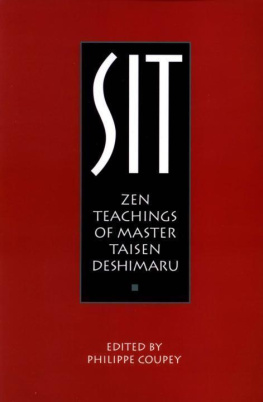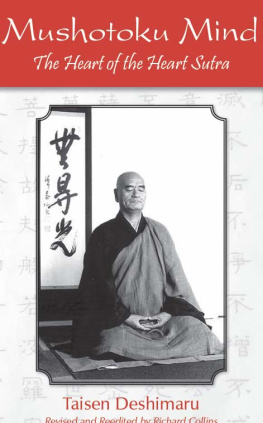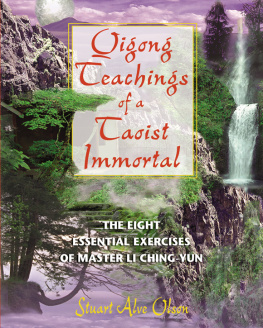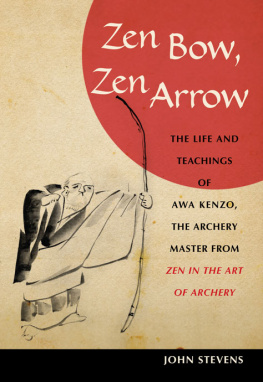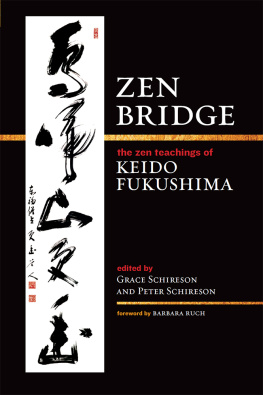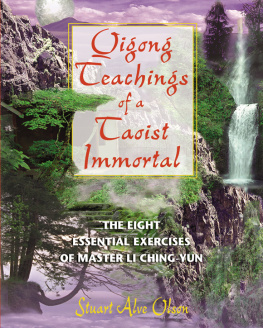Deshimaru Taisen - Sit: Zen teachings of master Taisen Deshimaru
Here you can read online Deshimaru Taisen - Sit: Zen teachings of master Taisen Deshimaru full text of the book (entire story) in english for free. Download pdf and epub, get meaning, cover and reviews about this ebook. City: Prescott;Ariz, year: 1996;2012, publisher: Hohm Press, genre: Religion. Description of the work, (preface) as well as reviews are available. Best literature library LitArk.com created for fans of good reading and offers a wide selection of genres:
Romance novel
Science fiction
Adventure
Detective
Science
History
Home and family
Prose
Art
Politics
Computer
Non-fiction
Religion
Business
Children
Humor
Choose a favorite category and find really read worthwhile books. Enjoy immersion in the world of imagination, feel the emotions of the characters or learn something new for yourself, make an fascinating discovery.
- Book:Sit: Zen teachings of master Taisen Deshimaru
- Author:
- Publisher:Hohm Press
- Genre:
- Year:1996;2012
- City:Prescott;Ariz
- Rating:5 / 5
- Favourites:Add to favourites
- Your mark:
- 100
- 1
- 2
- 3
- 4
- 5
Sit: Zen teachings of master Taisen Deshimaru: summary, description and annotation
We offer to read an annotation, description, summary or preface (depends on what the author of the book "Sit: Zen teachings of master Taisen Deshimaru" wrote himself). If you haven't found the necessary information about the book — write in the comments, we will try to find it.
Sit: Zen teachings of master Taisen Deshimaru — read online for free the complete book (whole text) full work
Below is the text of the book, divided by pages. System saving the place of the last page read, allows you to conveniently read the book "Sit: Zen teachings of master Taisen Deshimaru" online for free, without having to search again every time where you left off. Put a bookmark, and you can go to the page where you finished reading at any time.
Font size:
Interval:
Bookmark:



EDITED BY PHILIPPE COUPEY
I dedicate this book to the sitting dragon.
It tumbles over, turbulent like a cloud of rain.
One line becomes two, And were anyone to ask wherefrom comes its source, It's the fierce thunder whose roar breaks asunder the high rock.
Daichi, 1290-1366
I wish to thank Lee Lozowick and his editor Regina Sara Ryan for making this book available to the American public.
Let thanks also go to Eddy, Charles and Robert.
xxxiii
to his disciples during the summer of 1978 in Val d'Isere, France. The main subjects of these talks are Soto and Rinzai Zen. In addition to being a comparison of the two, it is a strong critique of both schools of Zen today.
IT'S AN EDUCATION
This book is about education. It brings up the fundamental question, what is the purpose of education? It is also, in a sense, a how-to-educate book. Do you just educate the frontal brain, while continuing to ignore the instinctive or central brain (the hypothalamus and thalamus), the connecting link between the body and the mind?
The idea of education is to develop the full human character, and to do this the entire body and mind, the entire brain, must come to life. Zen is a religion which thinks with both the head and the body.
Concerning this question of education, Doshu Okubo, the well-known professor and foremost specialist on Dogen, says: "Academic interpretations or presentations are not suitable for this purpose. First we must clarify what 'Zen' is, and then how it should be applied to education."' And that's what master Deshimaru attempts to do in these teachings.
MANY ZEN SCHOOLS
Originally there was one teaching, and each master was pointing to the same truth, the same source. There really wasn't anything which distinguished one from the other, beyond the character of the masters themselves. All the teachings came from the same root; they all had the same twenty-seven Indian patriarchs beginning with the Buddha, as well as the same six Chinese ones, beginning with the 1st Zen Patriarch Bodhidharma.
With the passing of time, however, disparity began to separate practitioners into different schools and finally into different teachings. By the time of Sekito (d. 790) there were a great many masters, and the disciples began to proclaim their own masters' teaching as the only true teaching.
Some schools were very wide and inclusive (like the Hogen school) and they mixed with the Nembutsu; others were exclusive of other practices (like the Soto school) and mixed with none. Some were very wild and rough (zusan), and yet others were soft and lenient (men-mitsu); some practiced with koans and kensho, while others practiced only zazen (shikantaza). What's more, Zen had become very polemical. There were lots of discussions between the different schools, and mondos and dharma combats flourished.This is why the ancient master Sekito, forefather to Soto Zen, composed his poem Sandokai. In those days, monks and others were much concerned with what teaching was so-to-speak "heretical," and what teaching was "traditional." In other words, what was "the right teaching" and what was not. Sekito in his Sandokai answers this question; and being the eternal question that it is, master Deshimaru answers it again, in our own times. At least I think so.
THE ORIGINS OF SOTO AND RINZAI ZEN
During Sekito's time there was another great master by the name of Baso. While it was Sekito's temperament to use the gentle (men-mitsu) method to awaken his disciples, Baso's way was to use the rough method of teaching (zusan). Indeed, Baso was most certainly the first great master to use this technique, that of the shout, the kick and the blow.
Baso (d. 788) set up his dojo at Kosei, west of the river Yangtse. At the same time, Sekito set up south of the lake ToungTing, and the disciples often travelled between the two. Though there existed little difference between masters Sekito and Baso themselves, the differences could be felt among their respective disciples. So you have the old expression: "West of the river, south of the lake."
Here perhaps is the true origin of Rinzai and Soto Zen"Rinzai" being the Baso dojo west of the river, and "Soto" being the Sekito dojo south of the lake. Consequently the true forefather of Rinzai Zen is Baso, and the true forefather of Soto is Sekito.

RINZAI & SOTO ZEN
Rinzai Zen was founded officially upon the teaching of master Rinzai (d. 867). Much of this teaching can be found in the Rinzai Roku (Record of Rinzai), a small one-volume work that was recorded by Rinzai's disciple Enen. Today this work is counted "among the classical works of Zen Buddhism," writes the prominent Buddhist scholar Heinrich Dumoulin; "indeed, among the classics of world religious literature."2 Anyway, it is this very text that master Deshimaru continually refers to in the following pages.
Soto Zen, which was founded shortly thereafter as a response to Rinzai Zen during the time of master Tozan (d. 869), is not based on any one book, nor on the teaching of any one master. Of course, there is Dogen and his celebrated work, the Shobogenzo, but this came much later, in thirteenth century Japan. So, while the Rinzai Roku is at the base of the Rinzai teaching, the Shobogenzo is not the base, but rather the confirmation of the so-called Soto Zen teaching (that is, the teaching of Bodhidharma, Eno and Nyojo, Dogen's own master).
Education for Dogen is the practice of being here now. The real form of Zen is not in theory or in different teaching techniques, says Dogen, but only in the actual practice, the practice entailing not just the mind but the body as well. Satori according to Soto (as opposed to Rinzai) is the excellent practice itself, shikantaza.
Rinzai Zen follows what they call a "special teaching" (kyo ge betsuden), something outside the scriptures and a little separated from the rest of Buddhism. Also, they are concerned with getting satori, and to obtain it they have worked out certain methods, one of them being the use of the koan. A koan is a statement, act or gesture which functions as a tool used to bring about the truth, satori.
The Soto school is not at all like the Rinzai one. In Soto there is no goal, no object: mushotoku. One practices for nothing. This is why many people who can't understand this, including certain Rinzai monks and Zen scholars, claim that the Soto practice of sitting "doing nothing" is good only for sleeping. The celebrated Professor D.T. Suzuki claims that if you practice just skikantaza, you will "fall into darkness." But zazen is not like this, it's not like sleep. To really sit in zazen you need to be awake to your breathing and attentive to your posture. "Zazen is on the one hand a resolute attitude and a strong posture," said master Deshimaru, "and on the other a delicate, elegant one, like the fragrance of sandalwood or incense."
Font size:
Interval:
Bookmark:
Similar books «Sit: Zen teachings of master Taisen Deshimaru»
Look at similar books to Sit: Zen teachings of master Taisen Deshimaru. We have selected literature similar in name and meaning in the hope of providing readers with more options to find new, interesting, not yet read works.
Discussion, reviews of the book Sit: Zen teachings of master Taisen Deshimaru and just readers' own opinions. Leave your comments, write what you think about the work, its meaning or the main characters. Specify what exactly you liked and what you didn't like, and why you think so.

